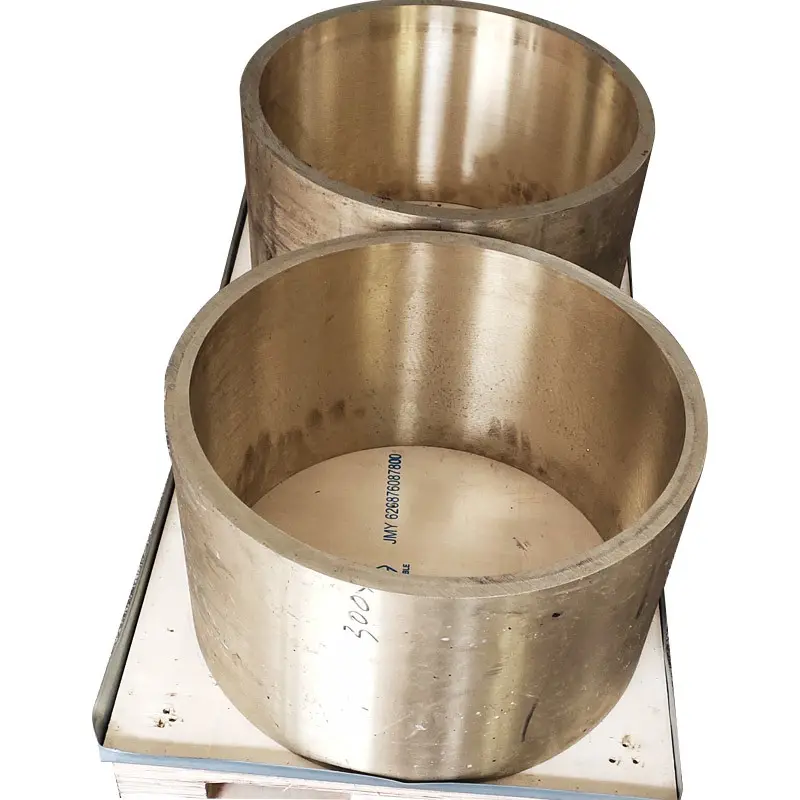
在造船業,選擇合適的螺旋槳製造材料對於確保最佳性能、耐用性和效率至關重要。在各種可用材料中,鋁青銅因其優異的強度、耐腐蝕性和可加工性組合而成為流行的選擇。然而,在螺旋槳製造方面,並非所有鋁青銅牌號都是一樣的。本文旨在探索不同等級的鋁青銅,並確定哪種最適合船用螺旋槳。
了解鋁青銅
鋁青銅是一類銅基合金,以鋁為主合金元素,通常還含有鐵、鎳和錳等附加元素。這些合金以其高強度、優異的耐腐蝕性(特別是在海水中)和良好的耐磨性而聞名。
螺旋槳製造的關鍵特性
在選擇用於螺旋槳製造的鋁青銅牌號碼時,必須考慮幾個關鍵特性:
- 力量
- 耐腐蝕性能
- 耐磨性
- 鑄造性
- 可加工性
- 抗疲勞性
- 抗氣蝕性
船用螺旋槳常用鋁青銅牌號
船用螺旋槳最常用的鋁青銅牌號碼是:
讓我們根據它們的化學成分和機械性能來比較這些牌號。
化學成分
下表顯示了這些鋁青銅牌號碼的典型化學成分:
| 年級 | 銅(%) | 鋁(%) | 鐵(%) | 在 (%) | 錳(%) | 其他 (%) |
|---|---|---|---|---|---|---|
| C95200 | 88-92 | 8-9.5 | 2.5-4 | – | 最多 1 個 | 0最大.5 |
| C95300 | 86-90 | 9-11 | 2.5-4 | – | 最多 1 個 | 0最大.5 |
| C95400 | 83-87 | 10-11.5 | 3-5 | 最大 1.5 | 最多 1 個 | 0最大.5 |
| C95500 | 78-82 | 10-11.5 | 3-5 | 3-5.5 | 最大 3.5 | 0最大.5 |
| C95800 | 79-82 | 8.5-9.5 | 3.5-4.5 | 4-5 | 0.8-1.5 | 0最大.5 |
機械性能
這些牌號的機械性能對於確定其是否適合螺旋槳製造至關重要:
| 年級 | 抗拉強度(兆帕) | 屈服強度(MPa) | 伸長率(%) | 布氏硬度 |
|---|---|---|---|---|
| C95200 | 第585章 | 275 | 20 | 150 |
| C95300 | 620 | 285 | 18 | 160 |
| C95400 | 690 | 345 | 12 | 190 |
| C95500 | 760 | 380 | 10 | 210 |
| C95800 | 690 | 275 | 15 | 170 |
評估螺旋槳製造的等級
現在,讓我們根據螺旋槳製造所需的關鍵特性來評估每個等級:
1.C95200(AB1)
- 強度:中等
- 耐腐蝕性:好
- 耐磨性: 中等
- 鑄造性:優秀
- 機械加工性:非常好
- 抗疲勞性:良好
- 抗氣蝕性:中等
C95200因其優異的鑄造性和良好的機械加工性而常用於中小型螺旋槳。然而,其中等強度和耐磨性可能限制其在較大或高性能應用中的使用。
2.C95300(AB2)
- 強度:良好
- 耐腐蝕性:很好
- 耐磨性: 良好
- 鑄造性:非常好
- 機械加工性:良好
- 抗疲勞性:良好
- 抗氣蝕性:良好
C95300 具有良好的性能平衡,適用於各種螺旋槳尺寸。與 C95200 相比,其強度和耐磨性得到提高,使其成為許多船舶應用的熱門選擇。
3.C95400(AB3)
- 強度:很好
- 耐腐蝕性:優秀
- 耐磨性:非常好
- 鑄造性:良好
- 機械加工性:良好
- 抗疲勞性:非常好
- 抗氣蝕性:非常好
C95400因其優異的強度、耐腐蝕性和耐磨性的結合而被廣泛應用於大型船用螺旋槳。其改進的機械性能使其適合高性能應用。
4.C95500(AB4)
- 強度:優秀
- 耐腐蝕性:優秀
- 耐磨性:優秀
- 鑄造性:良好
- 機械加工性:中等
- 抗疲勞性:優秀
- 抗氣蝕性:優秀
C95500 在這些牌號中具有最高的強度和耐磨性,使其成為大型高性能螺旋槳的理想選擇。然而,其機械加工性的降低可能會增加製造成本。
5.C95800(AB5)
- 強度:很好
- 耐腐蝕性:優秀
- 耐磨性:非常好
- 鑄造性:非常好
- 機械加工性:良好
- 抗疲勞性:優秀
- 抗氣蝕性:優秀
C95800 因其出色的性能平衡而被認為是船用螺旋槳的優質等級。它具有卓越的耐腐蝕性、良好的鑄造性以及優異的抗疲勞和抗氣蝕性能。
選擇螺旋槳製造的最佳牌號
選擇用於螺旋槳製造的最佳鋁青銅牌號碼取決於多種因素,包括:
- 螺旋槳尺寸
- 船舶類型和性能要求
- 操作條件(例如海水溫度、鹽度)
- 製造能力
- 成本考慮
為了幫助進行選擇過程,請考慮以下準則:
| 螺旋槳尺寸 | 船舶類型 | 推薦等級 |
|---|---|---|
| 小的 | 遊船、遊艇 | C95200、C95300 |
| 中等的 | 漁船、拖船 | C95300、C95400 |
| 大的 | 貨船、油輪 | C95400、C95500 |
| 非常大 | 貨櫃船、郵輪 | C95500、C95800 |
結論
雖然所有討論的鋁青銅牌號碼都為船用螺旋槳製造提供了優異的性能,但 C95800 (AB5) 脫穎而出,成為大多數應用的最佳整體選擇。其強度、耐腐蝕性、鑄造性和抗疲勞性的卓越組合使其成為各種螺旋槳尺寸和船舶類型的理想選擇。
然而,最終選擇應始終基於特定的專案要求和限制。對於較小的螺旋槳或要求較低的應用,C95300 或 C95400 可能提供更具成本效益的解決方案。相比之下,對於非常大或高性能的螺旋槳,C95500 可能是最佳選擇,儘管其成本較高且可加工性較低。
在選擇用於螺旋槳製造的鋁青銅牌號碼時,諮詢材料專家和螺旋槳設計師至關重要,以確保所選牌號滿足所有性能、耐用性和製造要求。透過仔細考慮每個等級的特性並將其與專案的特定需求相匹配,製造商可以確保螺旋槳在海洋環境中的最佳性能和使用壽命。
